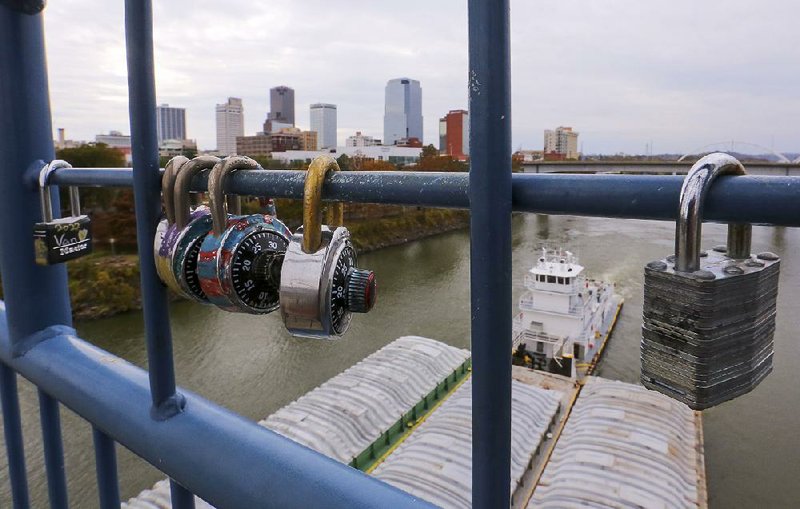The keepers of the Junction Bridge have no love lost for the love-struck linking their "love locks" to the historic bridge.
Today, workers will begin removing thousands of locks that romantic couples have attached to the 133-year-old pedestrian bridge over the Arkansas River between Little Rock and North Little Rock.
The practice, which is done on bridges around the world, "exploded" on the Junction Bridge this summer, bridge board Chairman Sarah Fritschie said.
The amorous tradition has run afoul of pragmatic authorities elsewhere, including Brooklyn and, yes, even in Paris, the romance capital of the world.
The credit, or the blame, for the "love locks" ritual has been traced to Federico Moccia, an Italian writer. His 2006 novel, I Want You, and subsequent film of the same name featured a hero who locked a chain around a lamppost on Rome's oldest bridge, the Ponte Milvio, and tossed the key into the Tiber, symbolizing that the couple would be together forever.
Pretty soon, locks and chains began appearing on the bridge. The ritual soon spread to bridges in Paris and other cities. But particularly Paris, where the Pont des Arts, a World Heritage site, and the tourists who flocked there soon were joined by graffiti, pickpockets and vendors selling cheap locks.
The practice eventually spread to 11 bridges across the French capital and to other landmarks, including the Eiffel Tower, to the point that more than 1 million locks "weigh the city down," according to the No Love Locks page on Facebook, which styles itself as a "grass-roots effort to create awareness of the damage to cultural heritage sites by the 'love locks' trend."
Paris banned the practice two years ago. Brooklyn followed a year later.
Locally, the problem hasn't been limited to the Junction Bridge, one of four area pedestrian river crossings.
"Yes, people have placed them on the Big Dam Bridge and the Two Rivers Bridge," said Cozetta Jones, spokesman for Pulaski County. "Our road and bridge crew cuts them off when they see them."
But the practice is nowhere near the problem on those bridges that it is on the Junction Bridge, where the locks line the railings on the upper section of the bridge, which is accessible only by stairs or an elevator. More locks can be found on the lower level, too.
"We appreciate the public interest and love of the Junction Bridge," Fritschie said in a prepared statement Tuesday. "An unintended problem is that the metal locks are continuously marring the bridge railings and removing the paint."
Fritschie didn't mince words in an interview.
"It's vandalism," she said. "It's the same as taking a Magic Marker and writing on a wall."
She and others who oversee maintenance of the bridge said the locks began appearing about two years ago. At that point, workers would remove them every two or three months, Fritschie said.
But the locks only encouraged more people to add their own locks, she said.
The encumbered railings are on top of the other vandalism the board has to tackle. Fritschie said $80,000 has been spent repairing vandalism over the past five years.
"I just signed a check for $7,000 to repair an electrical panel," she said.
The bridge elevator also is a target for vandals, Fritschie said.
The bridge is operated on an annual budget of more than $100,000, which is made of up of $35,000 annual contributions from Little Rock, North Little Rock and Pulaski County, she said.
"It costs a lot of money to maintain the bridge," Fritschie said.
The board is now taking aim at the locks, which come in all sizes, shapes and brands -- Master Lock and Brinks appearing to be the most common.
Jim McClelland, who is an engineer by profession and is the Junction Bridge Board's vice chairman, said the locks aren't enough to affect the structural integrity of the bridge. But repainting the bridge railing would be costly, he said.
Couples generally use permanent markers to put their names or initials and the date on the lock before attaching the lock to the railing and, presumably, tossing the key into the river below.
So the lock "Brian and Jenny" placed there on June 29, 2016, will soon be gone. So, too, will the one locked by "Brandon and Tiffany," as well as the one belonging to "Jess and Bree."
Work went into some of the locks. "Shane and Jennifer," whose lock is dated July 4, 2015, had their names engraved on their lock inside a heart.
"MFR" and "FST" also had their lock engraved to mark the 10th anniversary of their marriage, Aug. 29.
They won't get the locks back. The locks will be removed with bolt cutters and taken to a scrap yard. Fritschie said she didn't know how long it will take or how much it will cost.
"Unfortunately, the locks cannot be returned to the owners since there is no contact information for each owner and no one received permission to attach the locks to the railings," McClelland said.
Brandi Storey and Susan Roberson happened onto the bridge Tuesday afternoon for their first and perhaps last encounter with the locks. They are teachers at St. Theresa Catholic School and spent lunchtime in the River Market area on a break from doing volunteer work at Helping Hand, a local Catholic charity.
"I've heard of it," Storey said of the love locks trend. "But I didn't realize they were up here."
Roberson was saddened to learn they would be removed.
"We ought to protest," she said. "It's all about love. We don't see that too much anymore."
Metro on 11/15/2017
